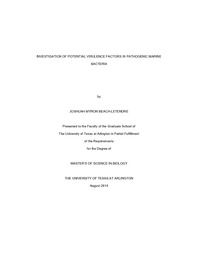| dc.description.abstract | Coral reefs provide numerous ecological and economic functions and are critical to biodiversity in marine environments. Critical to coral reef health and diversity is the microbial consortium within the coral host along with symbiotic algae. Coral reef invertebrate-microbe interactions within coral reef communities are rapidly shifting out of equilibrium throughout the globe. Higher temperatures are believed to be responsible for this destabilization. In this study, I assessed the production of potential virulence factors in previously isolated bacteria believed to contribute to disease symptoms in a major reef building coral, Orbicella faveolata. I measured the doubling times, respiration rates, biofilm production, serine protease production, and recovery when exposed to reactive oxygen species in potentially pathogenic bacterial strains (Vibrio splendidus 1H5, 3F8, 3B7, Aeromonas trotai 1A9, 2H12, Vibrio alginolyticus, and Vibrio campbelli 3A8) associated with Caribbean yellow band disease. The bacterial responses were measured across three different temperatures (26°C, 29°C, and 32°C) corresponding to ambient, elevated, and maximum sea surface temperatures recorded within the coral reef habitat. There were significant differences in temperature across all bacterial strains. Doubling times were generally higher at 29°C for all Vibrio spp. with the exception of V. alginolyticus. Respiration rate trends were similar in all bacterial strains and an elevation in temperature corresponded to an increase in respiration rate. V. alginolyticus displayed the fastest respiration rate in comparison to all other bacterial strains. Biofilm production increased as temperature rose in all bacterial strains with the exception of A. trotai 1A9 and V. campbelli 3A8. Defense against reactive oxygen species showed a general decrease in recovery time as temperature was elevated to 29°C. These findings suggest that while temperature does play a significant role in the doubling times of these potentially pathogenic species, growth is slowed at elevated temperatures in which Caribbean yellow band disease occurs at. The general pattern of increased respiration as temperature increases suggests that more energy is harnessed when temperatures are elevated. This may indicate that the potential for the synthesis of disease inducing factors increases as sea surface temperatures rise. The pattern of increased biofilm production in the majority of the bacterial strains as temperature is elevated indicates that these microbes may develop a resistance to antimicrobials secreted by the coral host. Further, there may be a dynamic trade off between bacterial strains in savaging the reactive oxygen species potentially secreted by the coral host and algal symbionts under thermal stress that allows for survival of a potentially pathogenic consortium of bacteria. These findings suggest that there is an allocation of energy between different systems with these bacterial strains may be critical to the progression of Caribbean yellow band disease in O. faveolata. The general increase in doubling time at 29°C coupled with increased respiration rates at elevated temperatures suggests that growth alone may not be the key contributing factor in disease progression. | en_US |

